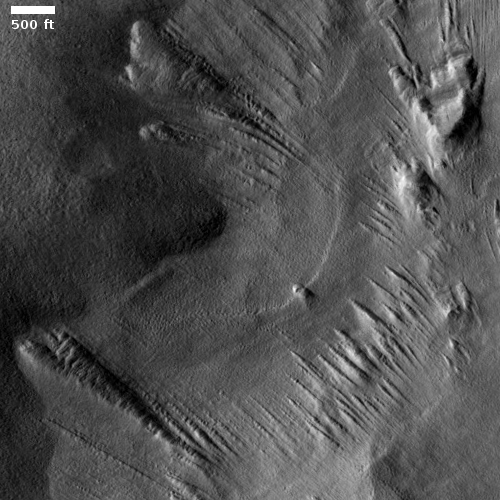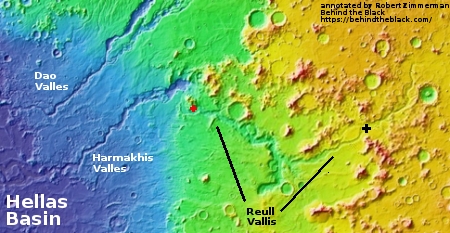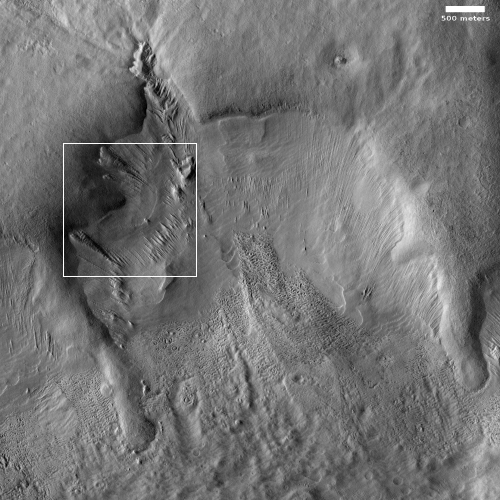Strange glacial flow features on Mars?
Cool image time! The photo to the right, rotated, cropped, and reduced to post here, was taken by the high resolution camera on Mars Reconnaissance Orbiter (MRO) on May 26, 2020, and shows what the scientists dub “Flow features in Reull Vallis.”
These features are typical in the mid-latitudes, and once again suggest the presence of buried glacial ice. The two lobes on the left and right both evoke such flows, as does the material in the drainage channel near the top of the photo.
What is more intriguing however are the strange features in the box. Below is that section, at full resolution.

The aligned ridges are quite interesting. Even more baffling are the ridges that get more pointed as they go downhill. This is completely the opposite what is usually seen, and is clearly seen in the two large lobes in the first image above. While the foot of a Martian glacial flow is not necessarily wider than its head, it generally is rounded like a lobe, which is why scientists dub them lobate.
For it to thin to a point as it goes down is puzzling. My guess is that we are seeing some evidence of erosion, or sublimation of that glacial material.
These flows are coming down off a mountain on the north wall of the downstream end of Reull Vallis, a 950 miles long and major meandering canyon in the Martian southern cratered highlands that drains into Hellas Basin, the death valley of Mars.

The overview map to the right provides the location context. Today’s image is indicated by the red cross. The black cross indicates the location of a previous cool image about Reull Vallis, which according to some scientists must have been formed by flowing water, as in a river. Based on more recent data and the accumulating evidence of extensive glacial activity in the Martian mid-latitudes, that conclusion is being challenged. Instead, it might be that such river-like meandering canyons might be the result of glacial flow over many eons.
The strange pointed ridges seen in today’s image might be evidence of the past cycles of glacial ebb and flow. Right now it is generally believed that the water ice is in steady-state between the poles and the mid-latitudes. At other times however that water either sublimated from the poles to the mid-latitudes, causing these glaciers to grow, or returned to the poles, causing these glaciers to shrink. The sharp ridges might indicate that shrink process.
Or not. I am guessing, based on my limited geological knowledge of Mars.
On Christmas Eve 1968 three Americans became the first humans to visit another world. What they did to celebrate was unexpected and profound, and will be remembered throughout all human history. Genesis: the Story of Apollo 8, Robert Zimmerman's classic history of humanity's first journey to another world, tells that story, and it is now available as both an ebook and an audiobook, both with a foreword by Valerie Anders and a new introduction by Robert Zimmerman.
The print edition can be purchased at Amazon or from any other book seller. If you want an autographed copy the price is $60 for the hardback and $45 for the paperback, plus $8 shipping for each. Go here for purchasing details. The ebook is available everywhere for $5.99 (before discount) at amazon, or direct from my ebook publisher, ebookit. If you buy it from ebookit you don't support the big tech companies and the author gets a bigger cut much sooner.
The audiobook is also available at all these vendors, and is also free with a 30-day trial membership to Audible.
"Not simply about one mission, [Genesis] is also the history of America's quest for the moon... Zimmerman has done a masterful job of tying disparate events together into a solid account of one of America's greatest human triumphs."--San Antonio Express-News
Cool image time! The photo to the right, rotated, cropped, and reduced to post here, was taken by the high resolution camera on Mars Reconnaissance Orbiter (MRO) on May 26, 2020, and shows what the scientists dub “Flow features in Reull Vallis.”
These features are typical in the mid-latitudes, and once again suggest the presence of buried glacial ice. The two lobes on the left and right both evoke such flows, as does the material in the drainage channel near the top of the photo.
What is more intriguing however are the strange features in the box. Below is that section, at full resolution.

The aligned ridges are quite interesting. Even more baffling are the ridges that get more pointed as they go downhill. This is completely the opposite what is usually seen, and is clearly seen in the two large lobes in the first image above. While the foot of a Martian glacial flow is not necessarily wider than its head, it generally is rounded like a lobe, which is why scientists dub them lobate.
For it to thin to a point as it goes down is puzzling. My guess is that we are seeing some evidence of erosion, or sublimation of that glacial material.
These flows are coming down off a mountain on the north wall of the downstream end of Reull Vallis, a 950 miles long and major meandering canyon in the Martian southern cratered highlands that drains into Hellas Basin, the death valley of Mars.

The overview map to the right provides the location context. Today’s image is indicated by the red cross. The black cross indicates the location of a previous cool image about Reull Vallis, which according to some scientists must have been formed by flowing water, as in a river. Based on more recent data and the accumulating evidence of extensive glacial activity in the Martian mid-latitudes, that conclusion is being challenged. Instead, it might be that such river-like meandering canyons might be the result of glacial flow over many eons.
The strange pointed ridges seen in today’s image might be evidence of the past cycles of glacial ebb and flow. Right now it is generally believed that the water ice is in steady-state between the poles and the mid-latitudes. At other times however that water either sublimated from the poles to the mid-latitudes, causing these glaciers to grow, or returned to the poles, causing these glaciers to shrink. The sharp ridges might indicate that shrink process.
Or not. I am guessing, based on my limited geological knowledge of Mars.
On Christmas Eve 1968 three Americans became the first humans to visit another world. What they did to celebrate was unexpected and profound, and will be remembered throughout all human history. Genesis: the Story of Apollo 8, Robert Zimmerman's classic history of humanity's first journey to another world, tells that story, and it is now available as both an ebook and an audiobook, both with a foreword by Valerie Anders and a new introduction by Robert Zimmerman.
The print edition can be purchased at Amazon or from any other book seller. If you want an autographed copy the price is $60 for the hardback and $45 for the paperback, plus $8 shipping for each. Go here for purchasing details. The ebook is available everywhere for $5.99 (before discount) at amazon, or direct from my ebook publisher, ebookit. If you buy it from ebookit you don't support the big tech companies and the author gets a bigger cut much sooner.
The audiobook is also available at all these vendors, and is also free with a 30-day trial membership to Audible.
"Not simply about one mission, [Genesis] is also the history of America's quest for the moon... Zimmerman has done a masterful job of tying disparate events together into a solid account of one of America's greatest human triumphs."--San Antonio Express-News


